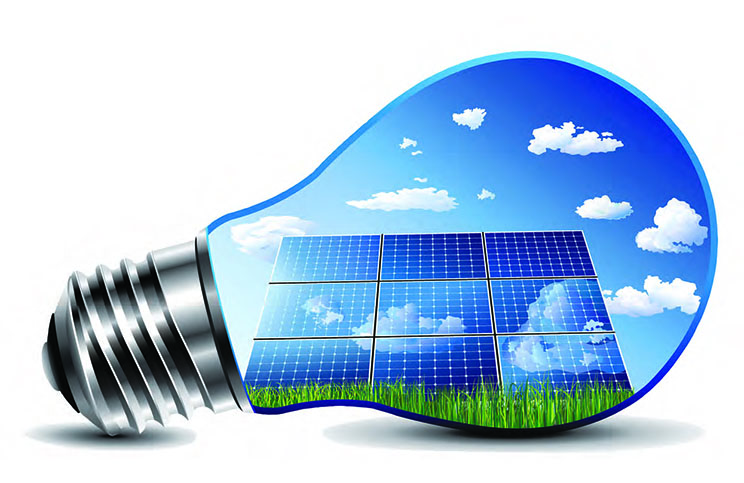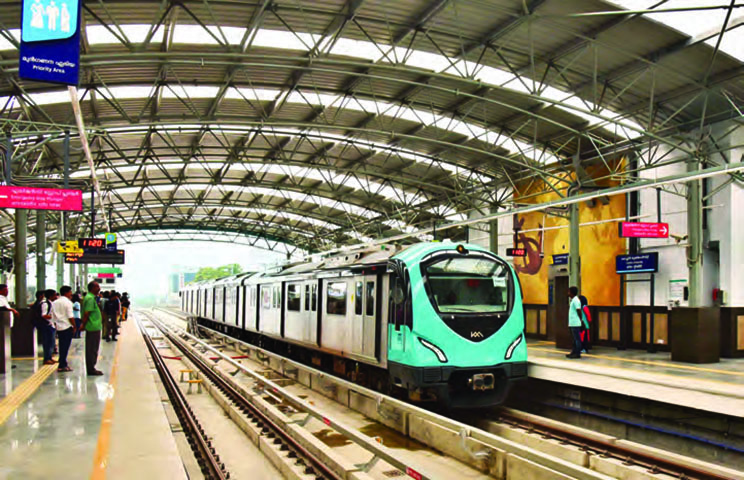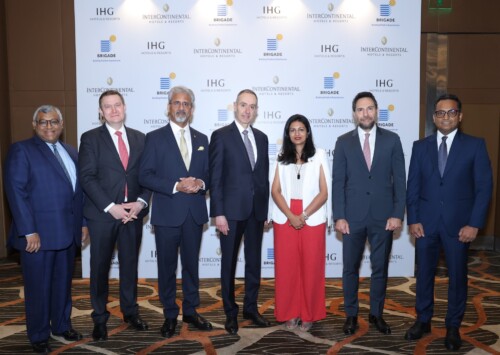New Green Initiatives
Biz@India
March 2018
India is taking a number of green initiatives and switching to renewable energy for its upcoming major projects. Trade ports, railway stations, and zoos are smartly and creatively being developed to minimise carbon emissions, making the country a fast growing green energy consumer. The country is also receiving aid from its international associates such as France, who are helping it achieve its ambitions.
As per the International Energy Agency (IEA), a Paris based intergovernmental organisation, India is the fastest growing energy consumer and market till 2040. The forecast also hints that the use of renewable energy – solar and wind – will be able to majorly fulfil the demand, particularly because of a sharp drop in the prices of renewable energy.
Currently India is largely dependent on fossil fuel imports to meet its energy demands, with about 70 pc of its electricity generation coming from burning them. Fuel imports are costing the country a huge amount in terms of its valuable foreign capital, which can be constrained if the needs are met by renewable energy. Switching to clean energy sooner rather than later would also bring India closer to its target of generating renewable energy of 175 gigawatt (GW) by 2022.
With its targets, India aims at producing and achieving enough renewable energy for its consumption. It is only second to China in green energy goals and has come up with various initiatives across sectors, to realise its ambition and gradually rise from its current base of 60 GW.
The country is taking various initiatives to make a switch in various fields, in order to rely more on renewable energy. With multiple projects in the pipeline and treaties like the International Solar Alliance (ISA), it is also showing its capability in producing green energy and leading others.
Facets of the ISA
To feed its demand of solar energy, and also of other nations, India has taken various steps forward, a major one being the framing of the ISA). An Indian initiative, it was jointly launched by the Prime Minister of India Narendra Modi and the former President of France Francois Hollande on November 30, 2015 in Paris, on the sidelines of COP-21, the UN Climate Conference.
The ISA is a global project whose key mission is to make available solar energy at an affordable rate, create solar grids and establish solar credit mechanism from solar rich countries (121 of them) lying fully or partially between the Tropic of Cancer and Tropic of Capricorn. The countries that receive maximum sunshine are on the African continent, ranging from Somalia to Egypt.
The ISA is the first treaty-based international, intergovernmental organisation to be based out of India. To kick-start its job, India has set aside USD 2 billion for solar projects in Africa out of the government’s USD 10 billion concessional line of credit for Africa.
India is joined by other prominent intergovernmental organisations in the energy sector include the Viennabased Organisation of the Petroleum Exporting Countries (Opec), and the IEA.
France is also financing the initial projects to be undertaken by the ISA, with the French Development Agency contributing EUR 300 million for the development of solar energy.
Other than this, French utility giant Engie, in a partnership with Dubai based Abraaj Group will be building more than 1,000 megawatt (MW) of wind power projects in India.
Through its ventures, the ISA is not only looking at producing solar energy but will also be exploring to reduce costs to aggregate the demand from member nations and then call for tenders. To start with, this approach is being explored for bringing down the cost of solar powered agricultural pumps. But while the global treaty has its targets set, there still remain challenges at a micro level that need to be fixed.
Also Read – Coming soon: A policy for charging stations for electric cars.
Will India achieve its clean energy target when its banks are investing in coal?
Challenges Pertaining to Producing Solar Energy
While India will be aiding generation of solar power in countries like Africa, it can’t overlook the issues it has and one regarding which only little can be done.
Due to the country’s varied climatic conditions, generating solar energy may be a challenge on any given day when the weather is cloudy, rainy, or with little or no sunlight. Moreover, only those areas that receive good amount of sunlight are suitable for producing solar energy. Space is also an issue as a large area of land is required to install a solar plant with solar panel. The land also remains occupied for many years and cannot be used for other purposes. Installing solar panels also require inverters and storage batteries to convert direct electricity to alternating electricity in order to generate electricity. While installing a solar panel can be affordable, installing other equipments can be expensive. Solar panels also demand considerable maintenance due to their fragile nature leading to incurring extra maintenance expenses.
Dust, high temperatures and the dearth of water contribute to a significant increase in the cost of operating solar power plants in the country. Some of these factors, such as the level of dust particles and the type of dust, vary from region to region within the country, while other factors such as the hardness of the water and the shortage of a skilled labour force are more general problems faced by plants across India. While the factor of dust contributes to increasing cleaning costs, shortage of skilled labour is hard to be dealt with in the interior regions of Rajasthan, Gujarat, Maharashtra, Madhya Pradesh, Chhattisgarh and parts of south India, which are major solar power generating states.
India’s massive power grid system also needs to be re-balanced in order to be made efficient enough to deal with the fluctuating/erratic nature of power generated from renewable energy flowing into the system and keeping supply in sync with demand.
The Indian government is fully supportive of the idea of producing and relying on renewable energy, but what India is currently lacking is consumer demand, which it needs to drive the market. Currently, various projects are being turned green, some that might even involve a direct participation from end-consumers, to inspire then to use renewable energy.
Going Green at Ports
India is ramping up its generation and use of renewable energy, with various initiatives in the pipeline to help achieve its green targets. By switching the power requirements of its 12 major domestic ports to renewable energy, India will become the first country in the world to run all government ports in a green way. All government owned ports will soon be functioning on solar and wind energy, after almost 200 MW solar and wind power generation capacity is generated at the ports by 2019. Of this, almost 150 MW will be solar power and 50 MW wind power. The capacity could be ramped up to 500 MW in the next few years, say reports.
Besides running the major ports on green energy, the government also has plans to meet the power requirements of smart port industrial cities coming up at Kandla Port, through renewable power sources.
Located in Gujarat, Kandla Port is one of the major ports on the west coast and one of the three that will be running on wind energy, the other two being VO Chidambaranar Port and Kamarajar Port in south India.
On the other hand, solar power plants have already been commissioned at Vishakhapatnam Port, Kolkata Port, New Mangalore Port, VO Chidambaranar Port, and Mumbai Port. The remaining solar power projects will be commissioned in phases and are expected to be completed by 2019. These projects are part of the green port initiative launched by the shipping ministry.
Railing Towards Renewable Energy
The Indian railways are the largest consumer of electricity in the country, with a majority of energy (85 pc) consumed to run trains, the rest for other chores. For feeding this huge demand, the authorities are now looking at sourcing a quarter of the power needs from renewable energy.
At present, about 45 pc of India’s 66,000 km railway network is electrified, the rest running on diesel, a fossil fuel responsible for causing dense pollution. The government now plans to electrify the entire network of Indian railways in the next 10 years with at least 90 pc of track electrification in the next five years.
Electrification necessarily may not mean clean power, it just means depending less on diesel. Nevertheless, moving to electricity powered locomotives and owning solar and wind power projects is a big step towards decarbonisation for the Indian railways. Green energy is something that the Indian railways need to implement in its system, considering the energy demand for the railways is set to triple from current levels to 49 terawatt-hour (TWh) by 2030, because of growing passenger footfall.
Apart from the need to cater to the increasing demand in a clean way, the Indian railways also require to fulfil its renewable energy targets and reduce emissions intensity by 33 pc within 2030 to be able to stick to its word in the Paris climate treaty.
Also Read – Green Initiatives.
India’s First Carbon Neutral Zoo
Haldwani, a city in the north Indian state of Uttarakhand has been in the news for development of the country’s first carbon neutral zoo. A significant step towards ecological conservation, the zoo will be spread over about 400-acre complex, using renewable resources like sun, water, and wind.
Approved by the central zoo authority, the zoo will replicate the environment of animals’ natural habitat to the maximum extent possible. With 19 segments, including a botanical garden and biodiversity park, it will be one-of-its-kind in the nation. Materials used in its construction – wood and other green components – will also be environment-friendly. Use of bricks, which are conventionally used in the construction of buildings will too be avoided to reduce carbon emissions.
“We have started plantation of various species that absorb carbon emitted in the environment fast, such as bamboo and grasses of various species. Use of timber and eco-friendly building material such as autoclaved, aerated concrete blocks will ensure carbon neutrality,” Indian media quoted Parag Madhukar Dhakate, director of the upcoming zoo, and conservator, western circle, forest department.
Wind and energy hybrid systems, wind turbines, fully automated organic waste composters, solar thermal water heating systems, solar street lighting, and bio-toilets will be at the helm of the zoo’s construction, promoting clean energy and waste management solutions.
International Collaborations
Apart from the joint venture, between Engie and Abraaj Group, in the wind power project, the former is investing in India in other sources as well.
“Energy demand is growing tremendously in India, and Engie is investing in green energy sources as part of supporting the country with its sustainable development plans,” Indian media quoted Sébastien Arbola, chief executive of Engie Middle East, South and Central Asia and Turkey.
On the other hand, India is looking at financial gains through means of foreign investments, which are crucial for the country’s renewable energy market as it is the lower cost of foreign capital and the size of the market that has helped the country bring down tariffs for green energy.
The project comes in the backdrop of India’s wind sector transitioning from a feed-in tariff regime to tariffbased competitive auctions. While feed-in tariffs ensure a fixed price for wind power producers, wind power tariffs in India followed the solar route and hit a record low of INR 3.46 (EUR 0.05) per kilowatt hour (kWh) in an auction conducted by Solar Energy Corporation of India.
In such a scenario, obtaining finance at the lowest cost has become key to success, resulting in record low solar and wind energy tariffs.
What does budget 2018 hold for renewable energy?
The renewable energy industry in India had a string of hopes from the budget of 2018. From extra capital allocation, discounts on taxes and duties, mechanism for timely payment from electricity distribution companies and a support system for start-ups, the sector had its share of anticipations. This is what the budget holds for it:
- The government has offered incentives to farmers to shift to solar power pumps. It was also stated that surplus electricity generated by the farmers will be bought by state electricity distribution companies (discoms) and will help boost India’s emerging green economy.
- With government’s support, farmers will now be able to install solar water pumps to irrigate their fields. There will also be necessary measures taken to put in place a mechanism that ensures that the farmers’ surplus solar power is purchased by the distribution companies or licensees at reasonably remunerative rates.
- The budget also announced that 20 GW of solar power capacity would be installed and 7,000 railway stations will be run on solar power.











